OCB & Culture: A Research Proposal Analysis in Chinese Organizations
VerifiedAdded on 2023/06/15
|7
|1144
|425
Case Study
AI Summary
This case study examines a research proposal by Lian, focusing on the application of organizational behavior theories in Chinese workplaces, specifically Organizational Citizenship Behavior (OCB). The analysis identifies concerns regarding the research design, title, questions, and objectives, particularly the contradictions between the broad scope of OCB and the narrow focus on a single Chinese organization. It suggests restructuring the title to 'The Impact of Organizational Citizenship Behavior on the Organizational Culture: A Case Study of China,' and proposes revised research questions and objectives to better align with an explorative research design. The analysis also emphasizes the importance of ethical considerations and appropriate sampling techniques for data collection. Desklib offers additional resources, including past papers and solved assignments, to aid students in understanding and applying these concepts.
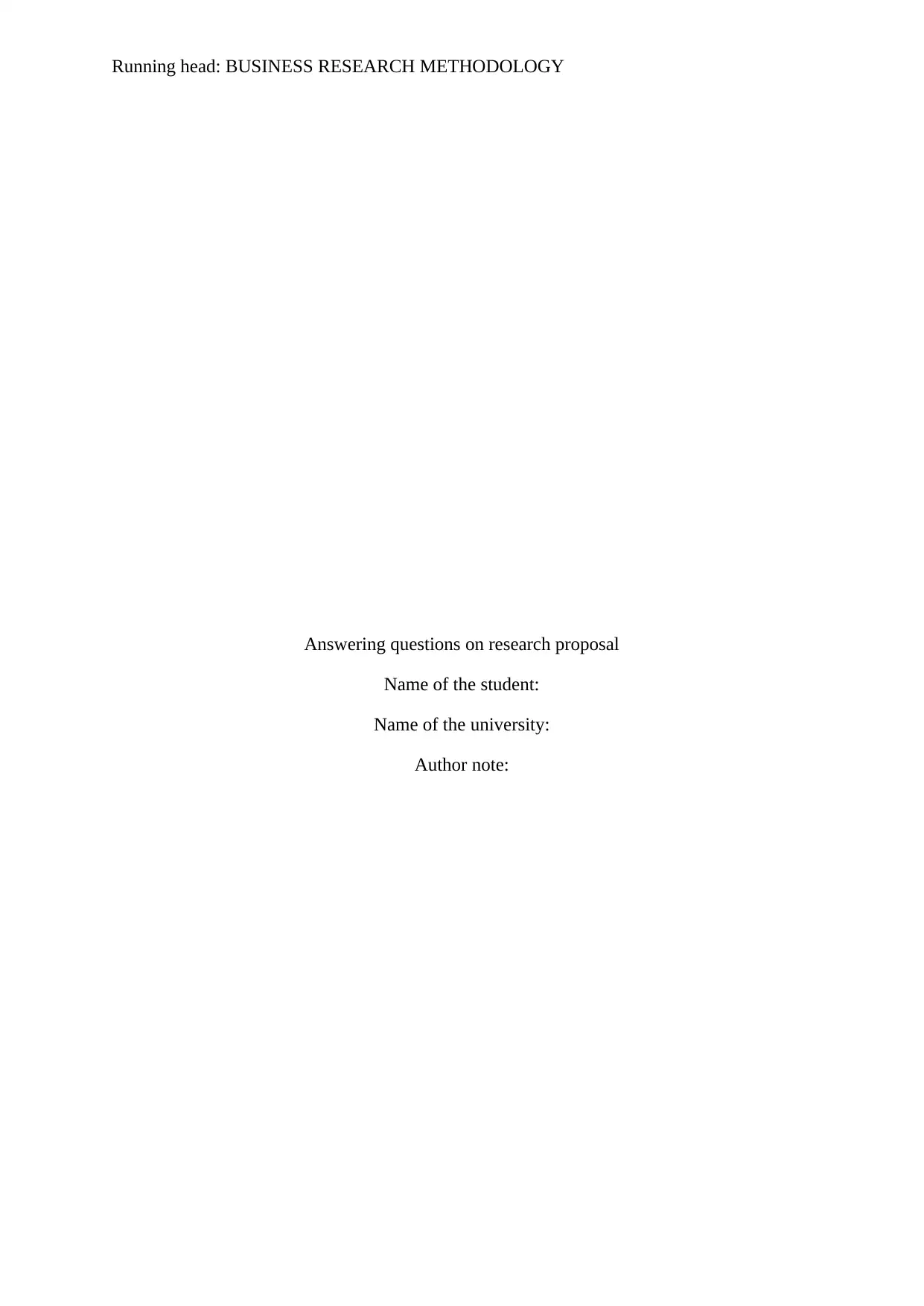
Running head: BUSINESS RESEARCH METHODOLOGY
Answering questions on research proposal
Name of the student:
Name of the university:
Author note:
Answering questions on research proposal
Name of the student:
Name of the university:
Author note:
Paraphrase This Document
Need a fresh take? Get an instant paraphrase of this document with our AI Paraphraser
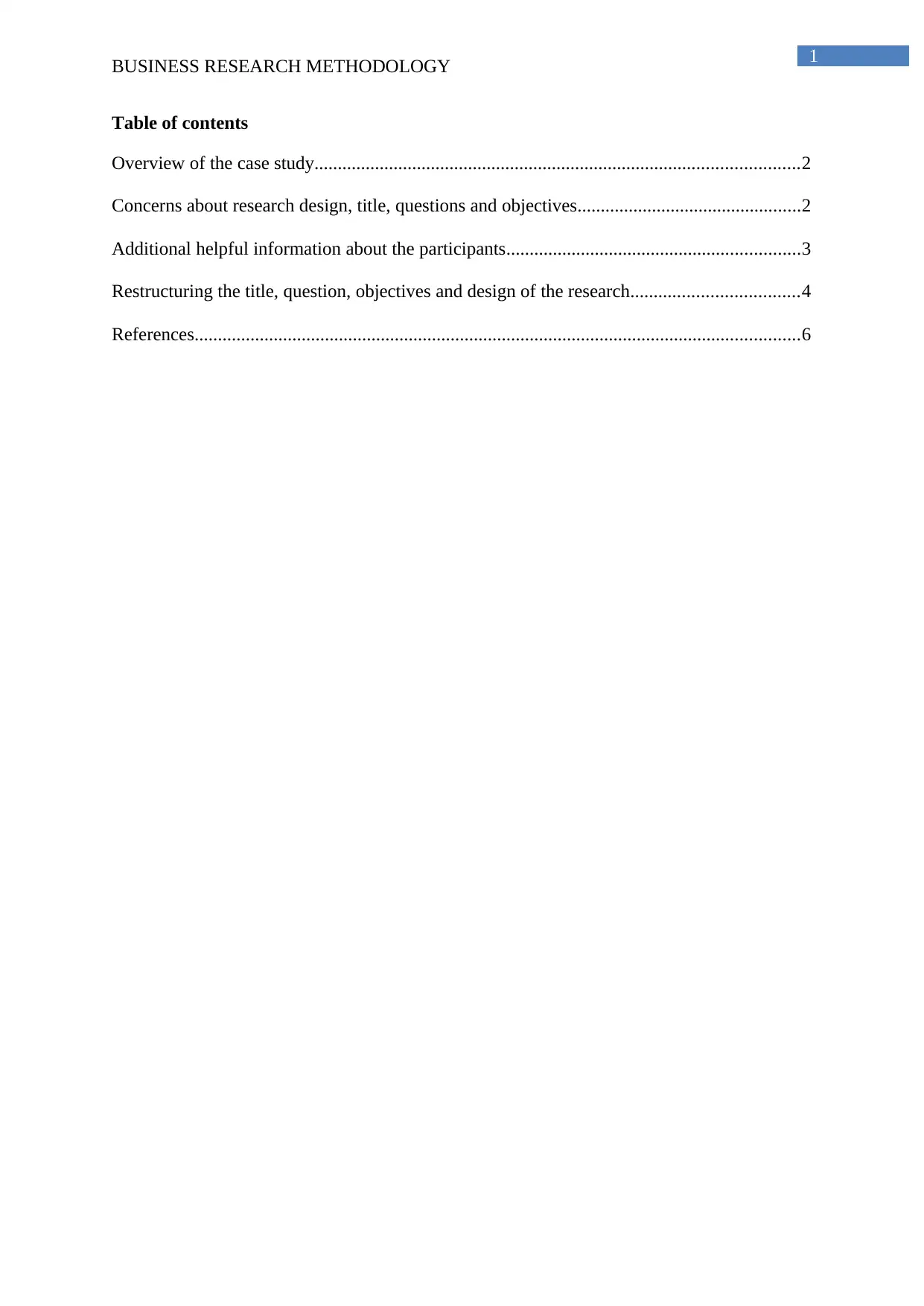
1
BUSINESS RESEARCH METHODOLOGY
Table of contents
Overview of the case study........................................................................................................2
Concerns about research design, title, questions and objectives................................................2
Additional helpful information about the participants...............................................................3
Restructuring the title, question, objectives and design of the research....................................4
References..................................................................................................................................6
BUSINESS RESEARCH METHODOLOGY
Table of contents
Overview of the case study........................................................................................................2
Concerns about research design, title, questions and objectives................................................2
Additional helpful information about the participants...............................................................3
Restructuring the title, question, objectives and design of the research....................................4
References..................................................................................................................................6
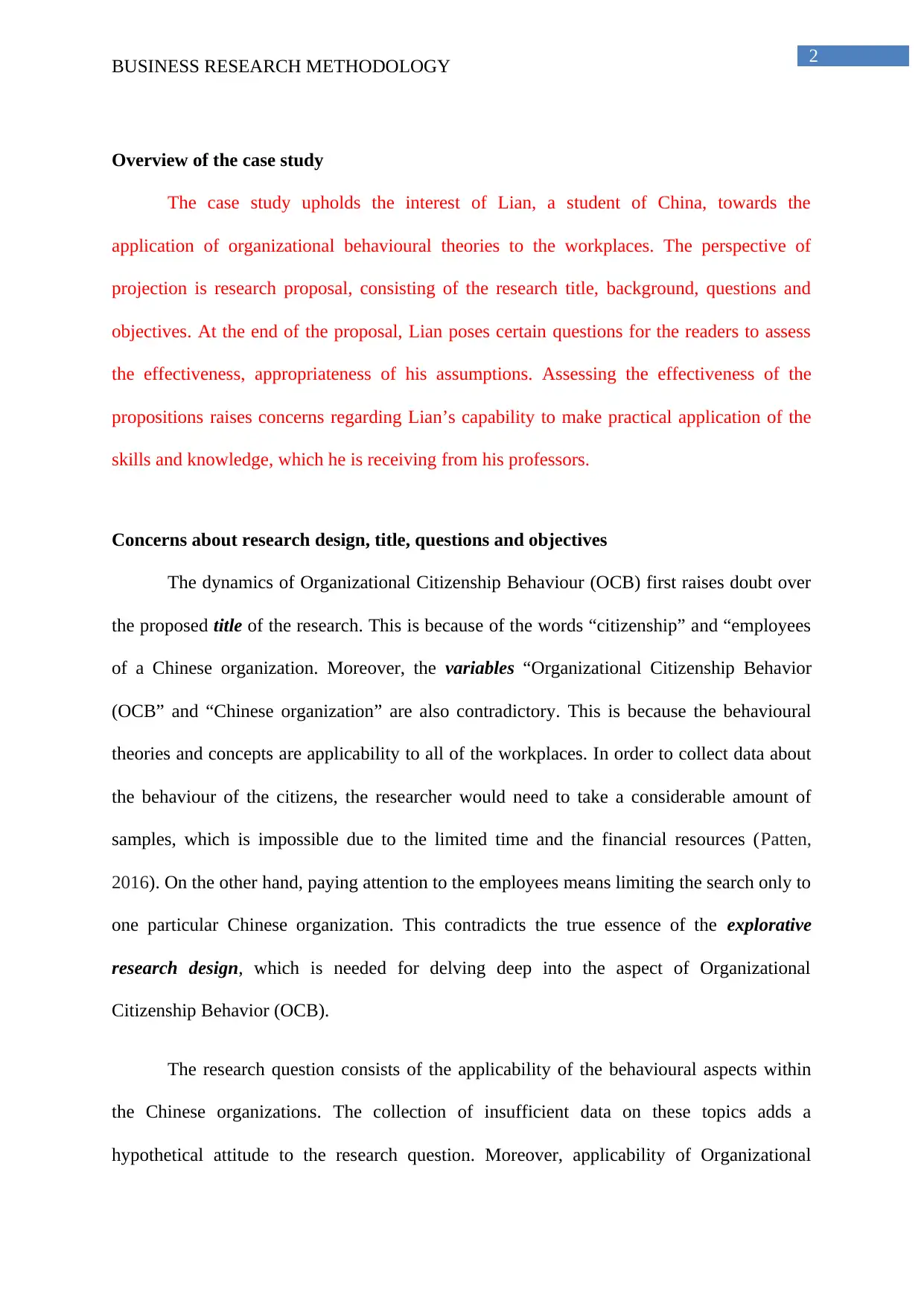
2
BUSINESS RESEARCH METHODOLOGY
Overview of the case study
The case study upholds the interest of Lian, a student of China, towards the
application of organizational behavioural theories to the workplaces. The perspective of
projection is research proposal, consisting of the research title, background, questions and
objectives. At the end of the proposal, Lian poses certain questions for the readers to assess
the effectiveness, appropriateness of his assumptions. Assessing the effectiveness of the
propositions raises concerns regarding Lian’s capability to make practical application of the
skills and knowledge, which he is receiving from his professors.
Concerns about research design, title, questions and objectives
The dynamics of Organizational Citizenship Behaviour (OCB) first raises doubt over
the proposed title of the research. This is because of the words “citizenship” and “employees
of a Chinese organization. Moreover, the variables “Organizational Citizenship Behavior
(OCB” and “Chinese organization” are also contradictory. This is because the behavioural
theories and concepts are applicability to all of the workplaces. In order to collect data about
the behaviour of the citizens, the researcher would need to take a considerable amount of
samples, which is impossible due to the limited time and the financial resources (Patten,
2016). On the other hand, paying attention to the employees means limiting the search only to
one particular Chinese organization. This contradicts the true essence of the explorative
research design, which is needed for delving deep into the aspect of Organizational
Citizenship Behavior (OCB).
The research question consists of the applicability of the behavioural aspects within
the Chinese organizations. The collection of insufficient data on these topics adds a
hypothetical attitude to the research question. Moreover, applicability of Organizational
BUSINESS RESEARCH METHODOLOGY
Overview of the case study
The case study upholds the interest of Lian, a student of China, towards the
application of organizational behavioural theories to the workplaces. The perspective of
projection is research proposal, consisting of the research title, background, questions and
objectives. At the end of the proposal, Lian poses certain questions for the readers to assess
the effectiveness, appropriateness of his assumptions. Assessing the effectiveness of the
propositions raises concerns regarding Lian’s capability to make practical application of the
skills and knowledge, which he is receiving from his professors.
Concerns about research design, title, questions and objectives
The dynamics of Organizational Citizenship Behaviour (OCB) first raises doubt over
the proposed title of the research. This is because of the words “citizenship” and “employees
of a Chinese organization. Moreover, the variables “Organizational Citizenship Behavior
(OCB” and “Chinese organization” are also contradictory. This is because the behavioural
theories and concepts are applicability to all of the workplaces. In order to collect data about
the behaviour of the citizens, the researcher would need to take a considerable amount of
samples, which is impossible due to the limited time and the financial resources (Patten,
2016). On the other hand, paying attention to the employees means limiting the search only to
one particular Chinese organization. This contradicts the true essence of the explorative
research design, which is needed for delving deep into the aspect of Organizational
Citizenship Behavior (OCB).
The research question consists of the applicability of the behavioural aspects within
the Chinese organizations. The collection of insufficient data on these topics adds a
hypothetical attitude to the research question. Moreover, applicability of Organizational
⊘ This is a preview!⊘
Do you want full access?
Subscribe today to unlock all pages.

Trusted by 1+ million students worldwide
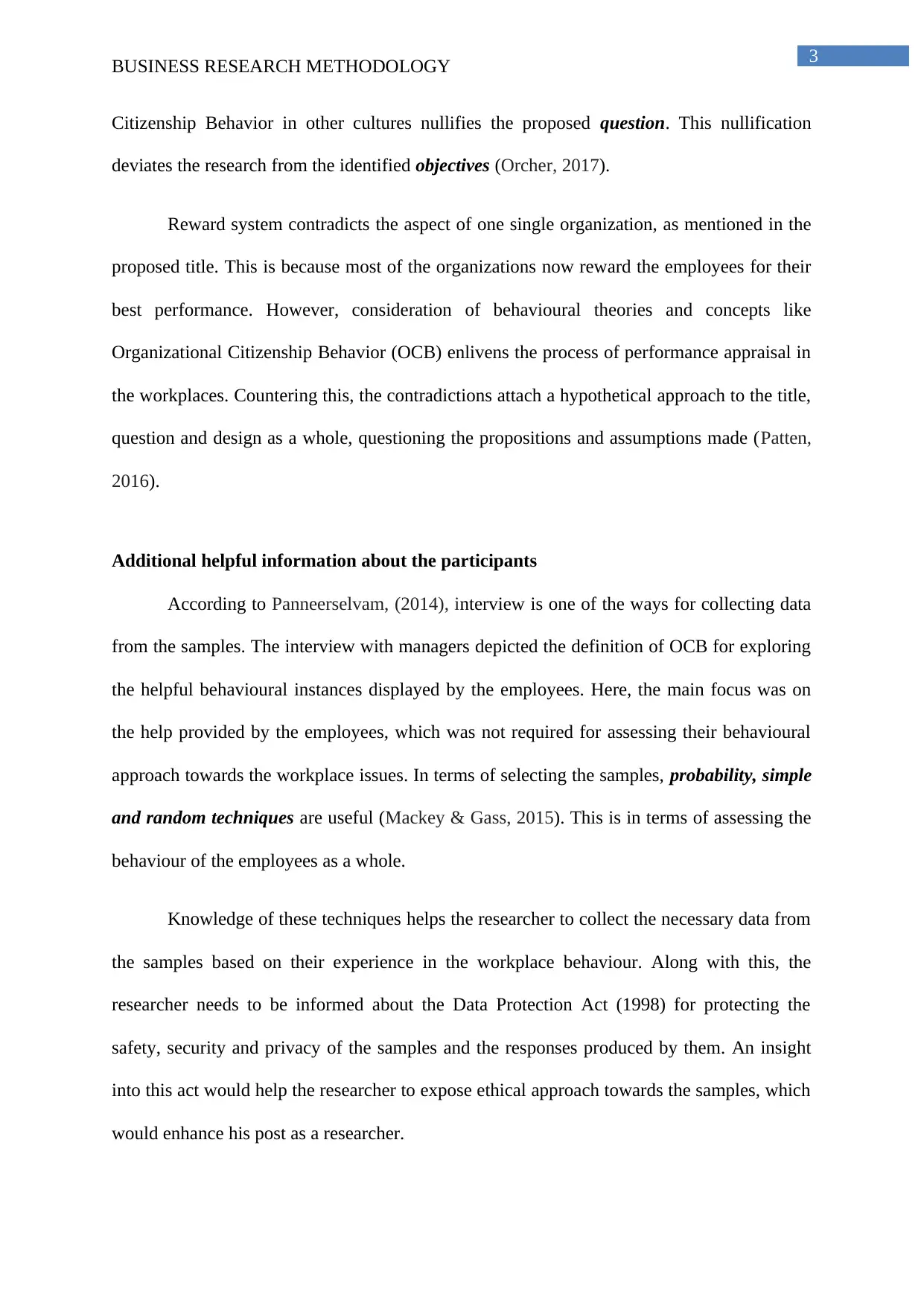
3
BUSINESS RESEARCH METHODOLOGY
Citizenship Behavior in other cultures nullifies the proposed question. This nullification
deviates the research from the identified objectives (Orcher, 2017).
Reward system contradicts the aspect of one single organization, as mentioned in the
proposed title. This is because most of the organizations now reward the employees for their
best performance. However, consideration of behavioural theories and concepts like
Organizational Citizenship Behavior (OCB) enlivens the process of performance appraisal in
the workplaces. Countering this, the contradictions attach a hypothetical approach to the title,
question and design as a whole, questioning the propositions and assumptions made (Patten,
2016).
Additional helpful information about the participants
According to Panneerselvam, (2014), interview is one of the ways for collecting data
from the samples. The interview with managers depicted the definition of OCB for exploring
the helpful behavioural instances displayed by the employees. Here, the main focus was on
the help provided by the employees, which was not required for assessing their behavioural
approach towards the workplace issues. In terms of selecting the samples, probability, simple
and random techniques are useful (Mackey & Gass, 2015). This is in terms of assessing the
behaviour of the employees as a whole.
Knowledge of these techniques helps the researcher to collect the necessary data from
the samples based on their experience in the workplace behaviour. Along with this, the
researcher needs to be informed about the Data Protection Act (1998) for protecting the
safety, security and privacy of the samples and the responses produced by them. An insight
into this act would help the researcher to expose ethical approach towards the samples, which
would enhance his post as a researcher.
BUSINESS RESEARCH METHODOLOGY
Citizenship Behavior in other cultures nullifies the proposed question. This nullification
deviates the research from the identified objectives (Orcher, 2017).
Reward system contradicts the aspect of one single organization, as mentioned in the
proposed title. This is because most of the organizations now reward the employees for their
best performance. However, consideration of behavioural theories and concepts like
Organizational Citizenship Behavior (OCB) enlivens the process of performance appraisal in
the workplaces. Countering this, the contradictions attach a hypothetical approach to the title,
question and design as a whole, questioning the propositions and assumptions made (Patten,
2016).
Additional helpful information about the participants
According to Panneerselvam, (2014), interview is one of the ways for collecting data
from the samples. The interview with managers depicted the definition of OCB for exploring
the helpful behavioural instances displayed by the employees. Here, the main focus was on
the help provided by the employees, which was not required for assessing their behavioural
approach towards the workplace issues. In terms of selecting the samples, probability, simple
and random techniques are useful (Mackey & Gass, 2015). This is in terms of assessing the
behaviour of the employees as a whole.
Knowledge of these techniques helps the researcher to collect the necessary data from
the samples based on their experience in the workplace behaviour. Along with this, the
researcher needs to be informed about the Data Protection Act (1998) for protecting the
safety, security and privacy of the samples and the responses produced by them. An insight
into this act would help the researcher to expose ethical approach towards the samples, which
would enhance his post as a researcher.
Paraphrase This Document
Need a fresh take? Get an instant paraphrase of this document with our AI Paraphraser
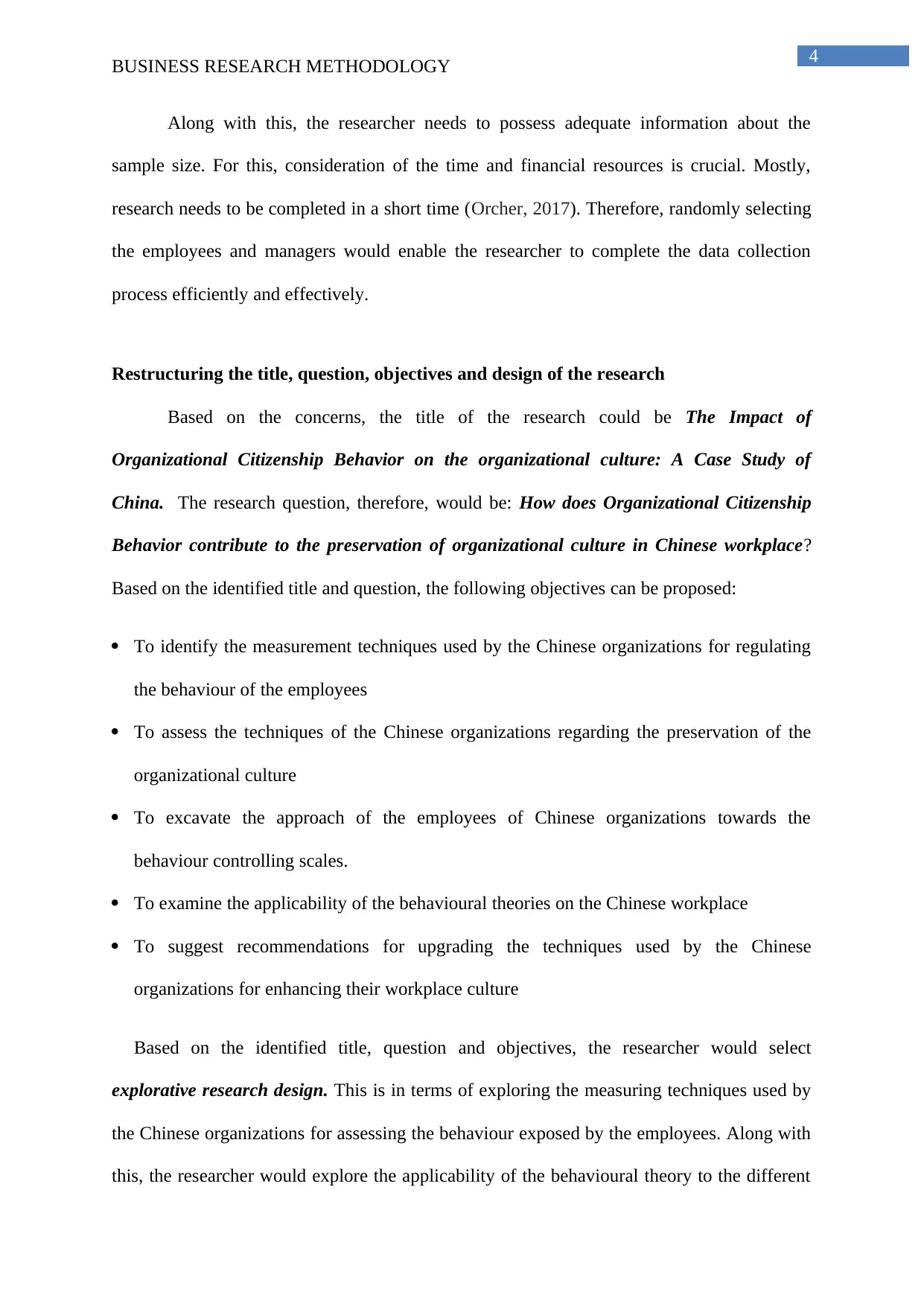
4
BUSINESS RESEARCH METHODOLOGY
Along with this, the researcher needs to possess adequate information about the
sample size. For this, consideration of the time and financial resources is crucial. Mostly,
research needs to be completed in a short time (Orcher, 2017). Therefore, randomly selecting
the employees and managers would enable the researcher to complete the data collection
process efficiently and effectively.
Restructuring the title, question, objectives and design of the research
Based on the concerns, the title of the research could be The Impact of
Organizational Citizenship Behavior on the organizational culture: A Case Study of
China. The research question, therefore, would be: How does Organizational Citizenship
Behavior contribute to the preservation of organizational culture in Chinese workplace?
Based on the identified title and question, the following objectives can be proposed:
To identify the measurement techniques used by the Chinese organizations for regulating
the behaviour of the employees
To assess the techniques of the Chinese organizations regarding the preservation of the
organizational culture
To excavate the approach of the employees of Chinese organizations towards the
behaviour controlling scales.
To examine the applicability of the behavioural theories on the Chinese workplace
To suggest recommendations for upgrading the techniques used by the Chinese
organizations for enhancing their workplace culture
Based on the identified title, question and objectives, the researcher would select
explorative research design. This is in terms of exploring the measuring techniques used by
the Chinese organizations for assessing the behaviour exposed by the employees. Along with
this, the researcher would explore the applicability of the behavioural theory to the different
BUSINESS RESEARCH METHODOLOGY
Along with this, the researcher needs to possess adequate information about the
sample size. For this, consideration of the time and financial resources is crucial. Mostly,
research needs to be completed in a short time (Orcher, 2017). Therefore, randomly selecting
the employees and managers would enable the researcher to complete the data collection
process efficiently and effectively.
Restructuring the title, question, objectives and design of the research
Based on the concerns, the title of the research could be The Impact of
Organizational Citizenship Behavior on the organizational culture: A Case Study of
China. The research question, therefore, would be: How does Organizational Citizenship
Behavior contribute to the preservation of organizational culture in Chinese workplace?
Based on the identified title and question, the following objectives can be proposed:
To identify the measurement techniques used by the Chinese organizations for regulating
the behaviour of the employees
To assess the techniques of the Chinese organizations regarding the preservation of the
organizational culture
To excavate the approach of the employees of Chinese organizations towards the
behaviour controlling scales.
To examine the applicability of the behavioural theories on the Chinese workplace
To suggest recommendations for upgrading the techniques used by the Chinese
organizations for enhancing their workplace culture
Based on the identified title, question and objectives, the researcher would select
explorative research design. This is in terms of exploring the measuring techniques used by
the Chinese organizations for assessing the behaviour exposed by the employees. Along with
this, the researcher would explore the applicability of the behavioural theory to the different
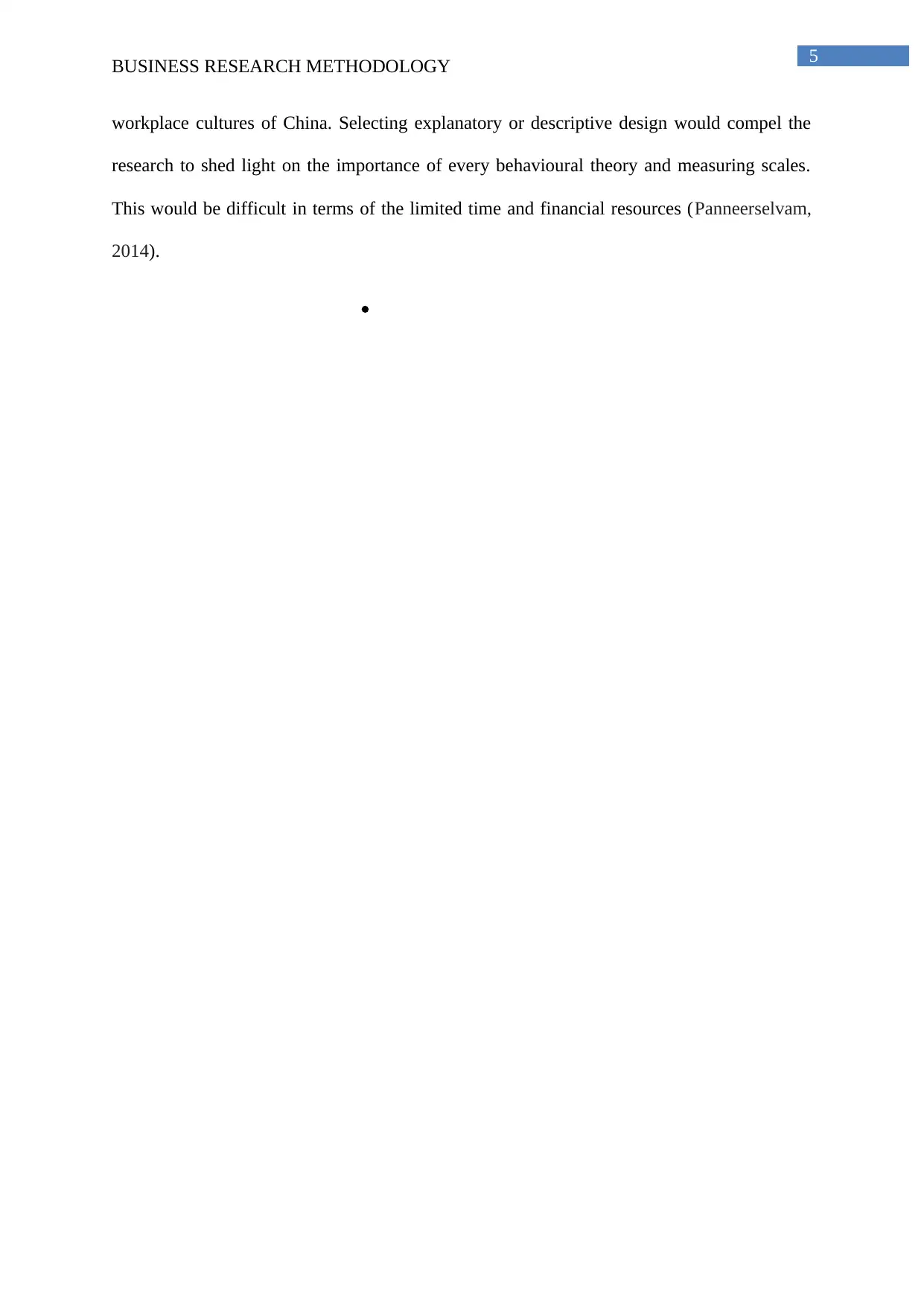
5
BUSINESS RESEARCH METHODOLOGY
workplace cultures of China. Selecting explanatory or descriptive design would compel the
research to shed light on the importance of every behavioural theory and measuring scales.
This would be difficult in terms of the limited time and financial resources (Panneerselvam,
2014).
BUSINESS RESEARCH METHODOLOGY
workplace cultures of China. Selecting explanatory or descriptive design would compel the
research to shed light on the importance of every behavioural theory and measuring scales.
This would be difficult in terms of the limited time and financial resources (Panneerselvam,
2014).
⊘ This is a preview!⊘
Do you want full access?
Subscribe today to unlock all pages.

Trusted by 1+ million students worldwide
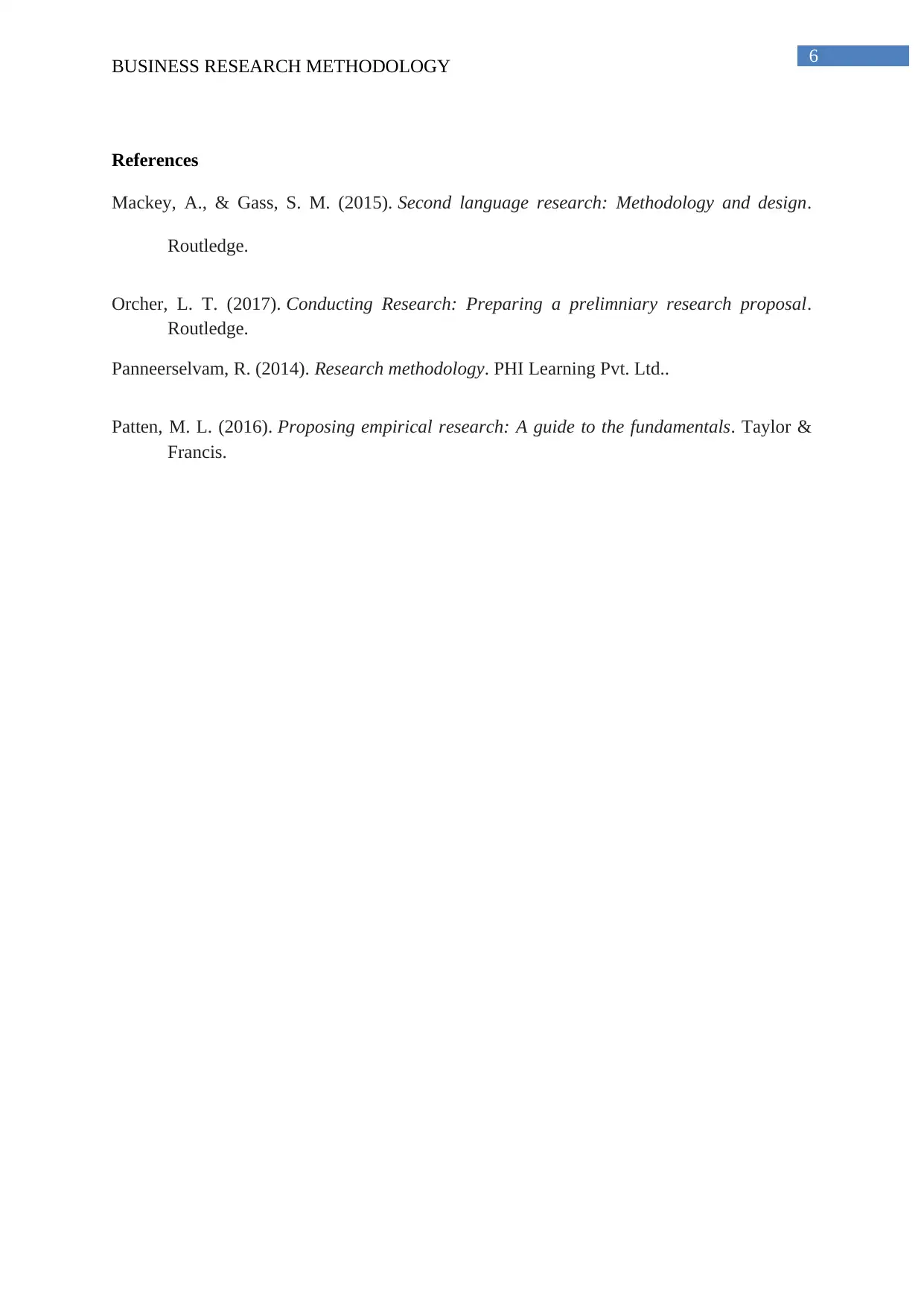
6
BUSINESS RESEARCH METHODOLOGY
References
Mackey, A., & Gass, S. M. (2015). Second language research: Methodology and design.
Routledge.
Orcher, L. T. (2017). Conducting Research: Preparing a prelimniary research proposal.
Routledge.
Panneerselvam, R. (2014). Research methodology. PHI Learning Pvt. Ltd..
Patten, M. L. (2016). Proposing empirical research: A guide to the fundamentals. Taylor &
Francis.
BUSINESS RESEARCH METHODOLOGY
References
Mackey, A., & Gass, S. M. (2015). Second language research: Methodology and design.
Routledge.
Orcher, L. T. (2017). Conducting Research: Preparing a prelimniary research proposal.
Routledge.
Panneerselvam, R. (2014). Research methodology. PHI Learning Pvt. Ltd..
Patten, M. L. (2016). Proposing empirical research: A guide to the fundamentals. Taylor &
Francis.
1 out of 7
Related Documents
Your All-in-One AI-Powered Toolkit for Academic Success.
+13062052269
info@desklib.com
Available 24*7 on WhatsApp / Email
![[object Object]](/_next/static/media/star-bottom.7253800d.svg)
Unlock your academic potential
Copyright © 2020–2025 A2Z Services. All Rights Reserved. Developed and managed by ZUCOL.





